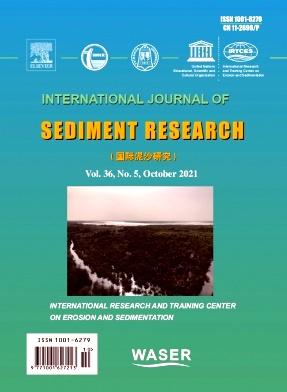Effects of three plant root systems on rill erosion characteristics on coal dump slopes under simulated experiments
IF 3.7
2区 环境科学与生态学
Q2 ENVIRONMENTAL SCIENCES
引用次数: 0
Abstract
Dump slopes have experienced severe rill erosion and threaten the safety of the ecological environment. Although vegetation restoration has improved the ecological environments of mining areas, because dump slopes have unique soil properties, the mechanism by which roots impact rill erosion on dump slopes remains unclear. Based on the in-situ runoff scouring experiment of the dump slope and the use of bare land as the control (CK), the influence of roots on rill erosion characteristics (RECs) of the dump slopes were analyzed for three root types of vegetation, specifically, tap root–Artemisia ordosica (AO), fibrous root–Elymus dahuricus (ED) and tap + fibrous root–Artemisia ordosica + Elymus dahuricus (AE). The results indicated that, compared to the CK, the roots reduced the rill erosion rate (Ts) by 75.61%–86.64% and the rill depth (Rd) by 64.62%–81.06% on the dump slopes. However, they increased the runoff depth (h) and Reynolds number (Re) by 2.02%–37.14% and 36.1%–172.0%. Among them, AO significantly increased Manning roughness coefficient (n), Darcy–Weisbach friction factor (f) and shear stress (τ), whereas ED and AE were most effective in reducing h and Ts, respectively. 59.9% of the RECs of dump slopes were explained by roots and hydraulic characteristics together. Furthermore, PLS-SEM analysis revealed that roots affect hydraulic characteristics by changing surface roughness and runoff friction resistance, ultimately leading to differences in the RECs of dump slopes, which explained 98.5% of the RECs on dump slopes with a 72.2% goodness-of-fit. The above results further enhance the understanding of the role of roots in controlling rill erosion on dump slopes.
模拟试验下三种植物根系对排土场边坡细沟侵蚀特性的影响
排土场边坡发生了严重的细沟侵蚀,威胁着生态环境的安全。虽然植被恢复改善了矿区的生态环境,但由于排土场边坡具有独特的土壤性质,根系对排土场边坡细沟侵蚀的影响机制尚不清楚。以裸地为对照(CK),进行了排土场坡面原位径流冲刷试验,分析了根系对排土场坡面细沟侵蚀特性(RECs)的影响,分别针对3种根系类型的植被,即tap根- ordosica (AO)、纤维根- Elymus dahuricus (ED)和tap +纤维根- ordosia ordosica + Elymus dahuricus (AE)。结果表明:与对照相比,排土场坡道根系减少了沟蚀速率(Ts) 75.61% ~ 86.64%,沟深(Rd) 64.62% ~ 81.06%;径流深度(h)和雷诺数(Re)分别增加了2.02% ~ 37.14%和36.1% ~ 172.0%。其中,AO显著提高了Manning粗糙度系数(n)、Darcy-Weisbach摩擦系数(f)和剪切应力(τ),而ED和AE对h和Ts的降低效果最为显著。排土场边坡59.9%的RECs可以用根系和水力特征共同解释。此外,PLS-SEM分析显示,根系通过改变表面粗糙度和径流摩擦阻力来影响水力特性,最终导致排土场边坡RECs的差异,这解释了排土场边坡98.5%的RECs,拟合优度为72.2%。上述结果进一步加深了对排土场边坡根系在控制细沟侵蚀中的作用的认识。
本文章由计算机程序翻译,如有差异,请以英文原文为准。
求助全文
约1分钟内获得全文
求助全文
来源期刊
CiteScore
6.90
自引率
5.60%
发文量
88
审稿时长
74 days
期刊介绍:
International Journal of Sediment Research, the Official Journal of The International Research and Training Center on Erosion and Sedimentation and The World Association for Sedimentation and Erosion Research, publishes scientific and technical papers on all aspects of erosion and sedimentation interpreted in its widest sense.
The subject matter is to include not only the mechanics of sediment transport and fluvial processes, but also what is related to geography, geomorphology, soil erosion, watershed management, sedimentology, environmental and ecological impacts of sedimentation, social and economical effects of sedimentation and its assessment, etc. Special attention is paid to engineering problems related to sedimentation and erosion.

 求助内容:
求助内容: 应助结果提醒方式:
应助结果提醒方式:


